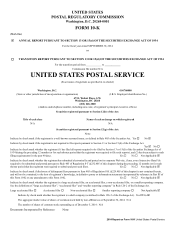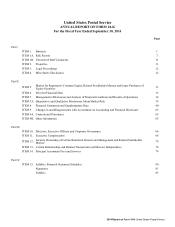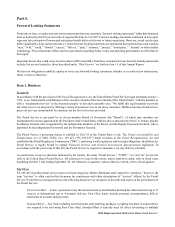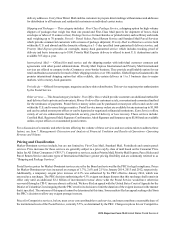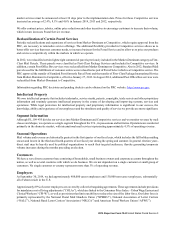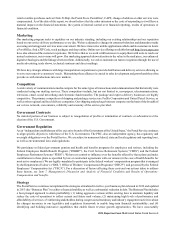US Postal Service 2014 Annual Report Download - page 11
Download and view the complete annual report
Please find page 11 of the 2014 US Postal Service annual report below. You can navigate through the pages in the report by either clicking on the pages listed below, or by using the keyword search tool below to find specific information within the annual report.
2014 Report on Form 10-K United States Postal Service 7
Item 1A. Risk Factors
Our business is subject to various risks and uncertainties that could adversely affect our business, financial condition, results of
operations and cash flows. In addition to the risks and uncertainties that are described below, there may be others that we do not
yet know of or that we currently think are immaterial that may also impair our business.
Adverse U.S. and global economic conditions directly impact our business, negatively affecting results of operations.
The demand for postal services is heavily influenced by the economy. Adverse economic conditions could negatively affect our
business and results of operations, primarily through disrupting our customers’ businesses. To the extent that the U.S. and other
countries continue to experience slow economic growth, our business, financial position and results of operations will continue
to be adversely impacted.
Our ability to generate sufficient cash flows from current and future management actions to increase efficiency, reduce costs
and generate revenue may not be sufficient to meet all of our financial obligations or to carry out our strategy.
Our strategies to increase efficiency and reduce costs by adjusting our network, infrastructure and workforce and to retain and
grow revenue are currently constrained by contractual, statutory, regulatory and political restrictions. Accordingly, our ability to
react quickly to the changing economic climate and industry conditions is inhibited.
We have proposed legislative changes that are needed to provide the Postal Service with the legal authority to implement
additional measures to increase efficiency and cost savings and to grow revenue. Legislation has been introduced in both houses
of Congress but has not been passed by either the Senate or the House of Representatives. Further, the proposed legislation does
not contain the authority necessary to implement all required actions to increase productivity and realize the cost savings in our
Business Plan.
We are subject to Congressional oversight and regulation by the Postal Regulatory Commission and other government
agencies. We have a wide variety of stakeholders whose interests and needs are sometimes in conflict.
We operate as an independent establishment of the executive branch of the Federal Government of the United States and as a
result are subject to a variety of regulations and other limitations applicable to federal agencies. If the Federal Government
curtails its spending due to debt ceiling constraints, we may be adversely impacted. Additionally, as an outgrowth of our unique
status as a provider of a fundamental service to the American people, we attempt to balance the interests of many parties. Efforts
to be responsive to various stakeholders sometimes adversely impact the speed with which we are able to respond to changes in
mail volume or other operational needs. Limitations on our ability to take management action could adversely affect operating
and financial results.
Adverse events may call into question our reputation for quality and reliability or our ability to deliver the mail and could
diminish the value of the Postal Service brand. This could potentially adversely affect our revenue and results of operations.
In its latest review of universal postal service providers, Oxford Strategic Consulting ranked the Postal Service as the best postal
service within the world’s top 20 largest economies for access to services, resource efficiency and public trust. The Postal
Service brand represents quality and reliable service; and therefore, is a valuable asset. We use our brand extensively in sales
and marketing initiatives and exercise care to defend and protect it. Any event, whether real or perceived, that calls into question
our long-term existence, our ability to deliver mail, our quality or our reliability could diminish the value of our brand and
reputation and could adversely affect our business operations and operating results.
Our need to restructure our operations in response to declining mail volume may result in significant costs. It is possible that
the measures being considered would be insufficient to reduce our workforce and physical infrastructure to a level
commensurate with declining mail volume.
Our current network optimization plans include the consolidation of certain mail processing operations and reductions in lobby
hours of many retail units, post offices and other facilities. Presently, our regular review of the carrying value of our assets has
not resulted in significant impairments of our physical assets. However, future changes in business strategy, legislation,
government regulations or economic or market conditions may result in material impairment write-downs of our assets. We
may, in the future, consider offering financial incentives to encourage employees to voluntarily leave the Postal Service, as has
been done in the past. Such impairments, incentives or other related costs would adversely impact our financial results in the
short-term, although they are expected to result in long-term savings. In addition, there is no assurance that the mechanisms

